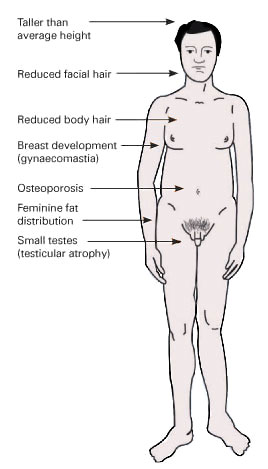Klinefelter syndrome

The karyotype ("profile of a persons chromosomes") of a normal human male is 46XY. If an individual has two or more X chromosomes then he is said to have Klinefelter syndrome.[1]
Symptoms:
An individual with Kleinfelter syndrome has a male phenotype, however they also possess a number of traits which are absent in a karyotypically normal male which are symptomatic of the disorder, these include:
- Reduced body hair growth i.e less chest and armpit hair growth than a normal male with less facial hair growth
- Development of breast tissue
- Usually tall
- Small testicles
- Lack of sexual maturation so individuals are usually sterile
Cause:
Normally sex chromosomes undergo segregation during Meiosis in gamete producing cells so each daughter cell contains one sex chromosome. However if this fails to occur gametes can be produced with an abnormal number of sex chromosomes (i.e in the case of Klinefelter syndrome an egg cell is produced with two X chromosomes) this process is callednondisjunction. If such a gamete is fertilised the resulting offspring will in turn have an abnormal number of sex chromosomes, which in this case causes Klinefelter syndrome, though a number of other genetic disorders exist caused by other sex chromosome abnormalities such as Turner syndrome (45,X).
Variants:
Although 47,XXY is the most common karyotype for individuals with Klinefelter syndrome a number of other aberrant karyotypes can cause Klinefelter syndrome. These include 48,XXXY, 48,XXYY and 49,XXXXY.
- ↑ (Genetics,analysis of genes and genomes,Hartl et al,2009)